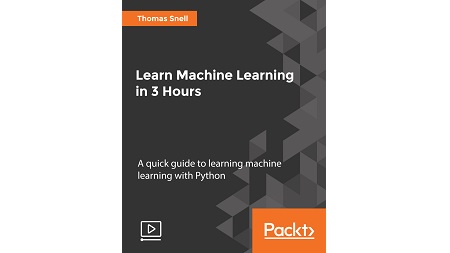English | MP4 | AVC 1920×1080 | AAC 44KHz 2ch | 2h 14m | 463 MB
Get hands-on with machine learning using Python.
Given the constantly increasing amounts of data they’re faced with, programmers have to come up with better solutions to make machines smarter and reduce manual work. In this Machine Learning course, you’ll use Python to craft better solutions and process them effectively.
We start by focusing on key ML algorithms and how they can be trained for classification and regression. We will also work with Supervised and Unsupervised learning to help to get to grips with both types of algorithm. We will use the highly popular Scikit-learn library throughout the course while performing various ML tasks.
By the end of the course, you will be adept at using the concepts and algorithms involved in Machine Learning. This is a highly practical course and will equip you with sufficient hands-on training to help you implement ML skills right after finishing the course.
This course consists of a series of worked example problems; for each worked example problem, we make use of different supervised and unsupervised Machine Learning algorithms. We also look at some smaller one-video worked examples to define a series of fundamental concepts which are crucial for reliably deploying stable Machine Learning systems in the real world.
What You Will Learn
- How Machine Learning algorithms fit data.
- Using PCA (Principal Component Analysis) to explore and visualize data easily.
- Implementing Unsupervised K-Means clustering.
- Leveraging the power of Unsupervised K-Nearest-Neighbor clustering.
- Effective implementation of Supervised SVM (Support Vector Machine) fitting
- Getting hands-on with Supervised Random Forest Fitting
- Implementing Supervised Gradient Boosting for classification
- Hyperparameter fitting and performance-tuning algorithms.
Table of Contents
01 The Course Overview
02 Operation of an Unsupervised Machine Learning Algorithm
03 Operation of a Supervised Machine Learning Algorithm
04 Avoid Overfitting and Splitting Data into Training and Testing Sets
05 Data Cleaning, Conversion, and Preprocessing
06 Using PCA to Easily Explore and Visualize Data
07 What Does the Unsupervised K-Means Clustering Algorithm Do
08 Example Problem
09 Data Preparation and Processing
10 Implementing K-Means Clustering
11 Improving Performance and Hyperparameter Fitting
12 Operation of the K-Nearest-Neighbor Classification Algorithm
13 Example Problem
14 Data Preparation and Processing
15 Implementing K-Nearest-Neighbor Classification
16 Improving Performance and Hyperparameter Fitting
17 Operation of the Support Vector Machine Classification Algorithm
18 Example Problem
19 Data Preparation and Processing
20 Implementing Support Vector Machine Classification
21 Improving Performance and Hyperparameter Fitting
22 Operation of the Support Vector Machine Regression Algorithm
23 Example Problem
24 Data Preparation and Processing
25 Implementing Support Vector Machine Regression
26 Improving Performance and Hyperparameter Fitting
27 Operation of the Gradient Boosting Algorithm
28 Example Problem
29 Data Preparation and Processing
30 Implementing Gradient Boosting Classification
31 Improving Performance and Hyperparameter Fitting
Resolve the captcha to access the links!
